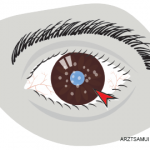Uveitis is an inflammation of the uvea, which comprises the iris, ciliary body and choroid. Uveitis can lead to ocular damage and complete visual loss.
Noninfectious etiologies for uveitis are the most common in the U.S.1 The estimated incidence of uveitis ranges from 25–52 per 100,000 in adults and five per 100,000 in children. The prevalence of uveitis ranges from 58–121 cases per 100,000 adults and 13–30 cases per 100,000 children.1-4
Pediatric patients present unique challenges for diagnosis and management.5 These challenges—difficult ophthalmic examinations, delayed diagnosis, medication side effects, adherence to treatment, risk of amblyopia and extended burden of disease into adulthood—require a multidisciplinary approach.6
Clinical Manifestations
Symptoms of uveitis vary based on the anatomic location of the inflammation. Among pediatric uveitis cohorts, anterior uveitis is most common, with estimates ranging from 30–70% of total cases.5,7,8 Although usually asymptomatic, anterior uveitis can present with eye redness, pain, tearing and photophobia. In contrast, inflammation in the intermediate and posterior aspects of the uvea often presents with floaters and blurred vision.
In North America, juvenile idiopathic arthritis (JIA) is the most common systemic disease associated with uveitis, and the condition occurs in 10–20% of children with JIA9-11 JIA-associated uveitis (JIA-U) is predominantly of the anterior uvea, affecting both eyes with non-granulomatous inflammation and characterized by a chronic and insidious course.12
Uveitis in the absence of known systemic disease is classified as idiopathic and is at least as common as JIA-U, with estimates ranging from 26–54% of all noninfectious uveitis cases.7,8,13,14 It can also be seen in other systemic inflammatory diseases, such as HLA-B27 disease, Behçet’s disease, sarcoidosis and vasculitides.15 Occasionally, patients may present with uveitis prior to developing systemic symptoms or signs.
Uveitis can lead to ocular complications, including cataracts, glaucoma, impaired visual acuity and blindness. These ocular complications appear in up to 50% of children affected. Despite advances in screening and treatment, vision loss (i.e., visual acuity of 20/50 or worse) occurs in 25–40%, and legal blindness (i.e., visual acuity of 20/200 or worse) in up to 25%.3,5,12,16-18
Guidelines for Uveitis Screening
The American Academy of Pediatrics (AAP) developed ophthalmology screening guidelines for children with arthritis because uveitis is typically asymptomatic in children (see Table 1).19 Screening intervals are based on risk factors, including articular features of disease (e.g., the category of JIA), anti-nuclear antibody (ANA) status, age at disease onset and disease duration.19,20 Children with oligoarticular or polyarticular rheumatoid factor (RF) negative JIA, with ANA positivity, who are younger than 7 years old at JIA onset and with a duration of JIA of four years or less are considered at high risk of developing uveitis—screen them every three months until they are 7 years old.18,20-23 Heiligenhaus et al. suggested including other JIA categories also at high risk for uveitis in the screening schedule (see Table 2).21


